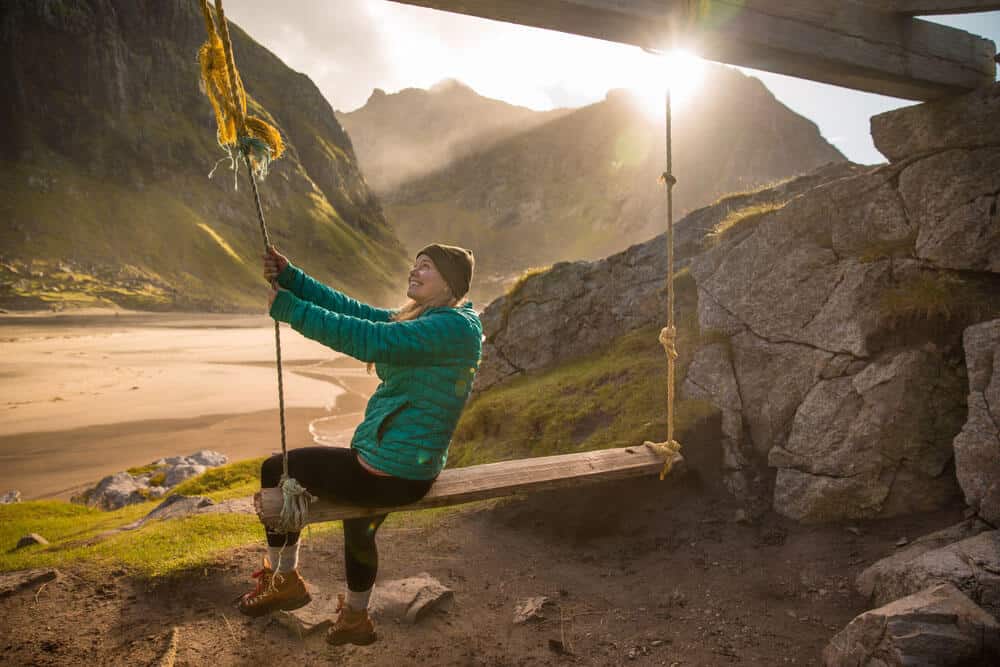A Wild South Island Road Trip
ChristchurchThe start of an adventure
Undoubtedly one of the major gateways to New Zealand is Christchurch, and it’s the best spot to begin and end a road trip around the South Island, which is a must-do. Non-negotiable. History suggests that Christchurch was settled as far back as 1000 years ago by Māori people, but it’s more well-known today for the earthquakes that destroyed a good deal of the city back in 2010 and 2011. Many people coming to New Zealand picture it for the scenery instead of cities, but my advice is to NOT miss out on Christchurch. It’s a city being rebuilt out of love, pride and dedication and it’s already emerging as New Zealand’s vibrant and creative capital.
An early morning walk through the Botanic Gardens is a personal fave along with punting down the river, and then grabbing breakfast at the legendary C1 Espresso. There is an amazing foodie and street art scene taking over the city, so don’t miss out on that.
Be sure to give yourself time to explore and wander and check out the Re:START mall, a temporary mall made out of shipping containers (a great place to visit for your local NZ souvenirs btw); Christchurch is incredibly walkable, and while it seems like everything is under construction, there are always the neatest spots and hangouts popping up over town waiting to be discovered. Head up the gondola at sunset to Port Hills for the best views around and for an epic way to see over the city.
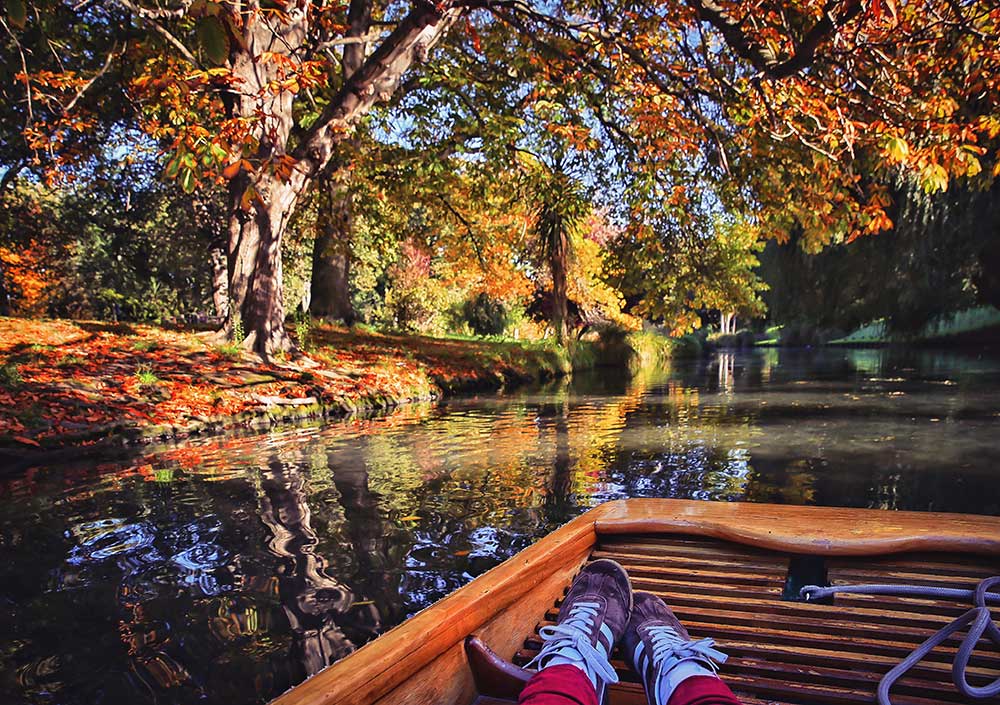
If you have the time, I also recommend hitting the road out to the Banks Peninsula outside the city and make your way to Akaroa. The Banks Peninsula is an extinct volcanic crater, an almost perfect circle and crater jutting out to the sea and radiating little bays and cute towns all around it.
The perfect day trip from the city (about an hour and 20 minute drive), you’ll definitely need a car to get to all the best spots. On your way, stop in the quaint port town of Lyttelton, and if you can swing it, splurge on a dinner at Roots, the best restaurant in New Zealand. Take the Summit Road scenic route that traces the rim of the ancient volcano, though not for the faint of heart (think narrow gravel road with no guardrails), but you’ll be rewarded with absolutely epic views the whole way towards Akaroa, the heart of the Banks Peninsula.
If you have a mild obsession for alpacas like I do or generally being on a farm, be sure to stop by Shamarra Alpacas, which has great views over the peninsula and is one of my favorite spots. Eventually make your way to Akaroa, New Zealand’s first French settlement, and a cute seaside town to visit. Check out the quirky Giant’s House and go for a swim with the local Hector’s Dolphins, the smallest and most endangered dolphin in the world. My favorite place to stay out on the Banks Peninsula is at the very unique PurePod in Little River, and entirely glass cabin out in the middle of nowhere.
Arthur's PassTraversing the Alps
There are only three roads that traverse the mighty Southern Alps, the mountains that form the backbone of the South Island, and Arthur’s Pass is one of them. An incredibly scenic drive through the mountains, I definitely recommend going through here on a South Island road trip. An easy hour and 20 minute drive from Christchurch towards Arthur’s Pass will bring you through an interesting little park area called Castle Hill (Kura Tāwhiti). Blink, and you’ll miss it. Kura Tāwhiti was once a meeting place for early Māori and has strong cultural significance here. As the the plains open up to the foothills of the mountains, you will start to feel like you really are in Middle Earth as you get your first taste of that epic South Island scenery, though the reality is that it was used as a filming location for the Chronicles of Narnia.
Be sure to stop and go exploring amongst the towering limestone boulders, and even try out climbing if you’re experienced. If you’re feeling adventurous, bring some warm clothes and a head torch and you can go explore a natural cave at the Cave Stream Scenic Reserve.
Carry on another forty minutes up the road towards the mountains and you’ll arrive at the little village of Arthur’s Pass. On your way you’ll pass the classic club skifield of Craigieburn, not for the faint of heart or those afraid of old school nutcracker ropetows that’ll drag you up the mountain.
The heart of the Southern Alps, Arthur’s Pass is one of my favorite places to visit, rain or shine. There are walks for every level of fitness and plenty of multi-day backcountry hikes for experts. I always make the trip up to the Devil’s Punchbowl Waterfall because it’s truly epic and only an hour return. Avalanche Peak is the most popular walk in the area climbing up to over 1000 meters with great views of the mountains, though it’s pretty hard. There is another clubfield called Temple Basin in Arthur’s Pass if you find yourself there in winter.
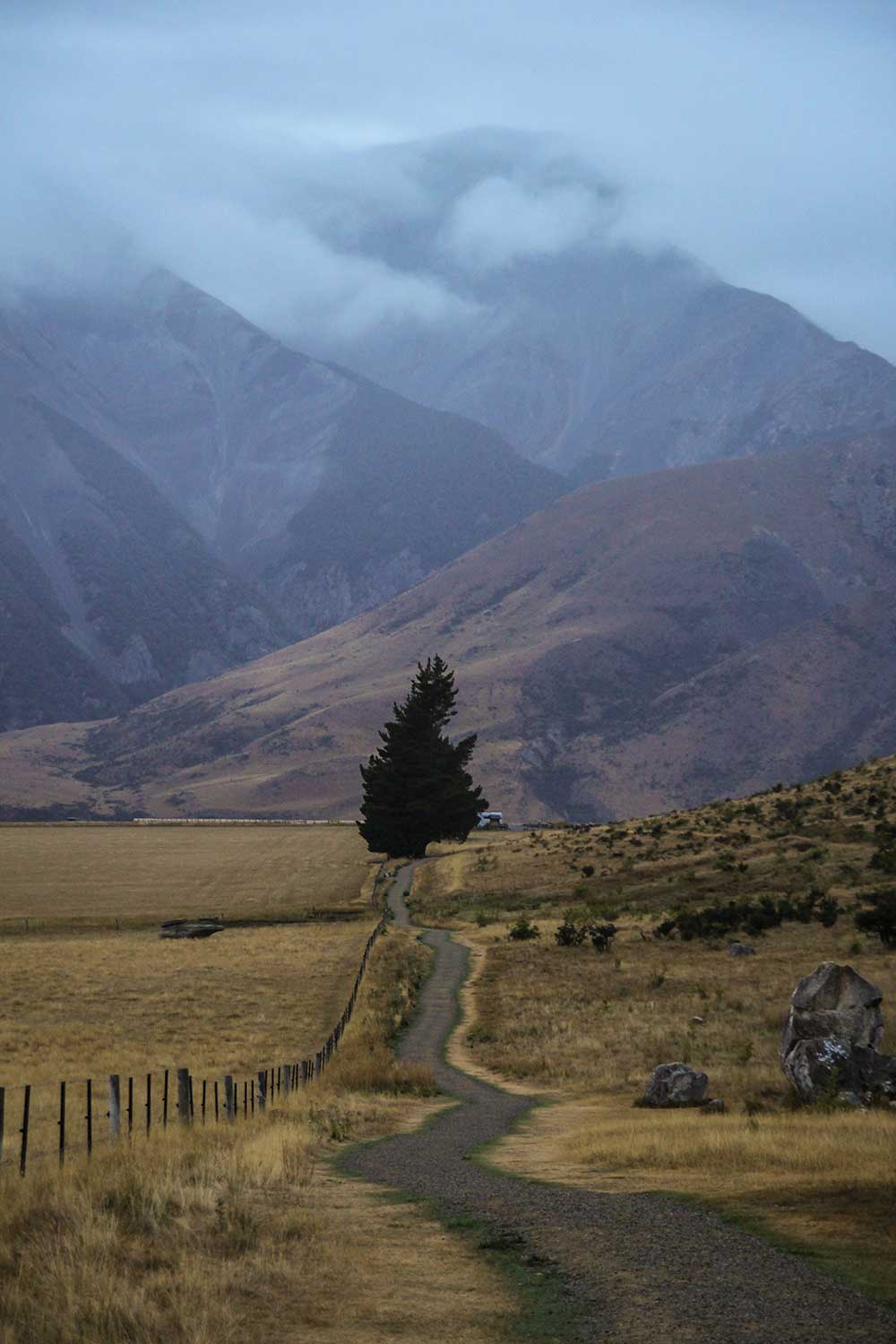
The stretch of road from Arthur’s Pass down to the West Coast is one of my favorites in all of New Zealand. An hour and 15 or so to Hokitika, be sure to build in time to stop at all the viewpoints, including the overlook at the actual top of the mountain pass, a good spot for seeing some young kea, New Zealand’s famous cheeky alpine parrot. But don’t feed them! You’ll even get to drive under a waterfall. Be sure to keep an eye on road warnings and be wary of heading through Arthur’s Pass is very bad weather because sometimes the road closes due to slips, snow and other crazy mountain weather.
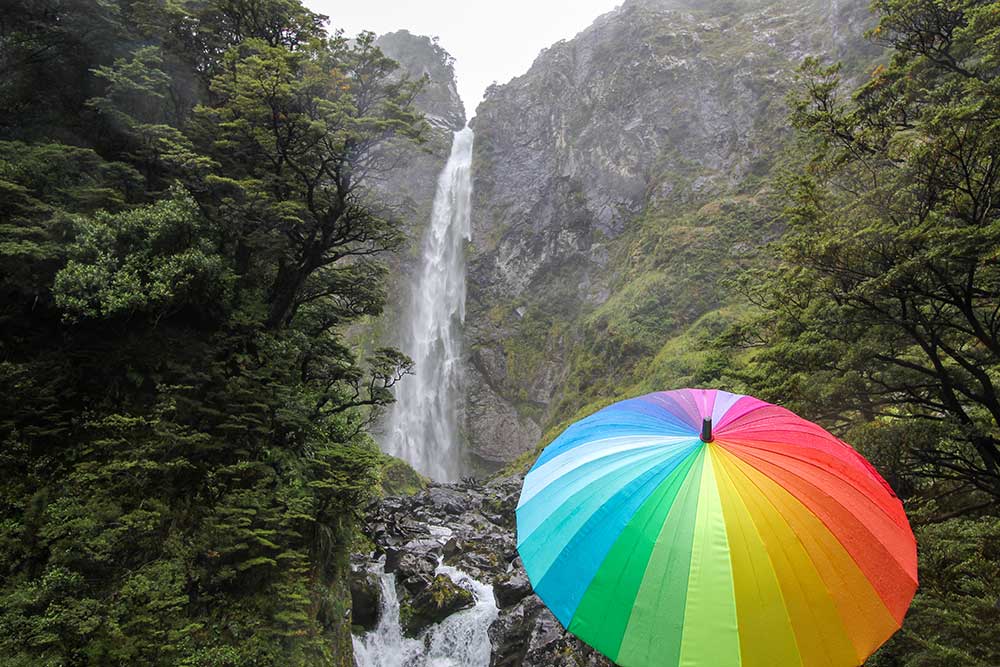
Fox GlacierThe Wild West Coast
If I had to chose, I’d say the drive down the West Coast of the South Island is one of my faves. It is a stunner! Definitely stop in Hokitika – it’s one of my favorite weird little towns on the west coast. Originally settled back in 1860 during the gold rush, it used to be so much bigger than it is now. You’ll see lots of shops selling the traditional pounamu (greenstone) but remember you aren’t meant to buy it for yourself – it should be gifted.
The beach in tow has a cool driftwood sign and in the end of summer there is a wild foods festival for adventurous eaters. On your way south, be sure to make time to head inland (30 minutes) and see the Hokitika Gorge, an easy track that’ll bring you to a swing bridge over quite possibly the most neon turquoise river gorge you’ve ever laid eyes on – though note it can change color depending on super heavy rainfall in the mountains. If you have the time, go glamping at Hurunui Jacks, it’s one of my favorite spots in all of the South Island, and it’s an unforgettable experience.
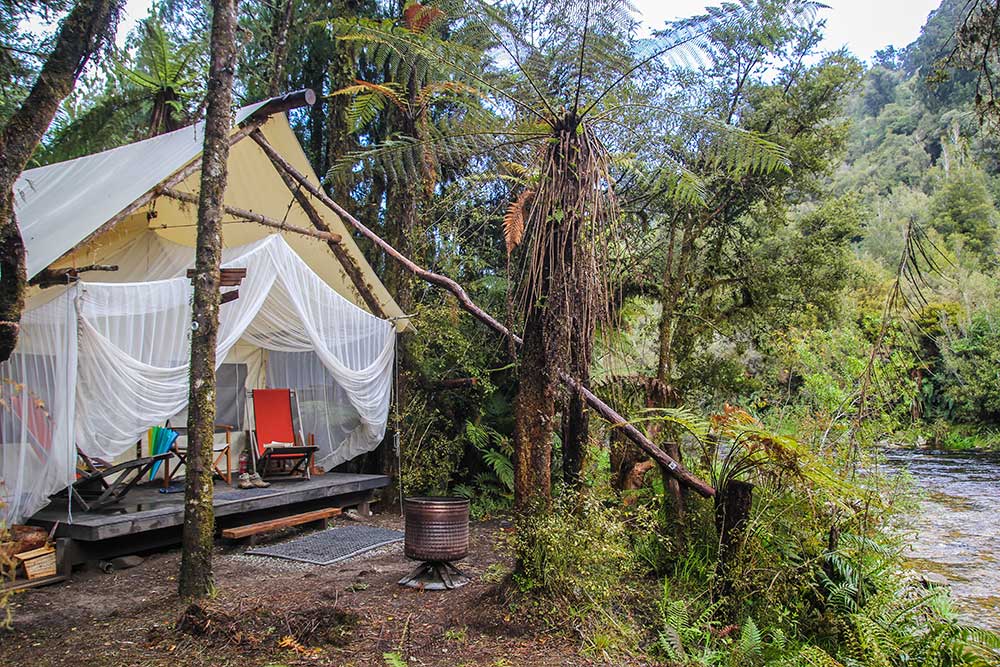
Be sure to give yourself a day or two in the little town of Fox Glacier, one of my favorite places on the South Island. Franz and Fox Glaciers snake down from the top of the Southern Alps almost to sea level, making them two of the most easily accessed glaciers in the world. Blue rivers of ice, they are wondrous to behold, and if you splurge on any activity in the South Island, make sure it’s on a heli-hike on one of them.
A half an hour drive apart along a winding coastal mountain road, I tend to stay in Fox Glacier over Franz, the quieter of the two west coast glacier towns. Both Franz and Fox have day walks you can do to viewpoints of the glaciers; you use to be able to walk right onto the ice, but they have retreated so much they’ve become unstable, limiting access to helicopters or experts only. Definitely do a heli-hike on Fox Glacier, and if you’re an adventurous spirit, opt in for the Extreme Fox, which is longer on the ice and let’s you learn all sorts of glacier skills.
There are awesome hikes and walks near Franz and Fox Glaciers, and definitely take the time to walk around nearby Lake Matheson, which often has spectacular reflections of Fox Glacier and Mt. Cook. Journey just a bit further and you’ll end up at Gillespies Beach, a great place to camp.
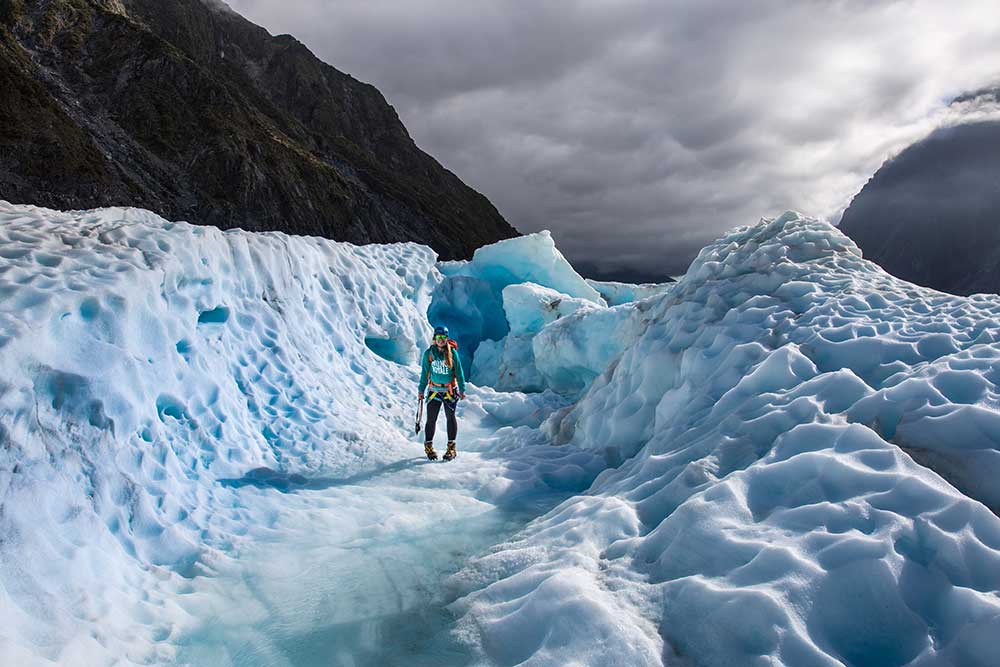
WanakaOver the Haast Pass
The drive inland from Fox Glacier to Wanaka is jaw-dropping. Seriously. Think lush rainforest, wild beaches, glacial rivers and mirror lakes, all bordered by the soaring Southern Alps. I know, I probs sound a little gushy – but that’s what the West Coast does to a person.
You’ll first continue along the shoreline before traveling over Haast Pass – a particularly magical traverse and one of my favorite places to go off the grid (there’s no mobile coverage here, something that both thrills and annoys me in equal measure) and on towards lakes Hawea and Wanaka. Historically this route was used by the Māori people journeying West in search of Pounamu – and you’ll note that many of the stones found on the beaches and riverbeds carry a greenish hue. Although the drive is only three and a half hours, plan to spend a least a day on the road as there’s plenty to explore along the way.
Heading south from Fox it’s about an hour to Haast and there’s a heap of interesting stops as you go. You’ll travel through the rainforest canopy before hitting the coast at Bruce Bay – hop out for a glimpse of the Tasman Sea then continue on towards World Heritage Site Lake Moeraki – a pristine icy pool surrounded by native vegetation. I highly recommend doing the nearby Monro Beach Walk for a chance to see the rare Fiordland Crested Penguin. The best viewing times are early morning/evening during the months of August to November – so if you’re a bird geek like me, plan your trip accordingly people!
A little further on you’ll come to Knights Point Lookout with its spectacular views of rugged clifftops and wild ocean beyond – but beware the sand flies! Apply Deet liberally unless you’d rather catch the scenery from your car. The final stretch of this leg takes you through the dilapidated settlement of Haast. Although outwardly a little tired, Haast has definite kiwi charm and is well worth a look. Be sure to take the thirty minute detour from Haast to Jackson Bay, a remote fishing port with breathtaking scenery, spectacular walks and an interesting whaling history. It’s also rated one of New Zealand’s ‘best kept’secrets.

Leaving Haast, the journey inland to Wanaka is roughly two and half hours with no phone reception. You’ll follow the highway past braided river flats and lush foliage before steadily winding your way through the narrow gorge. Although truly spectacular when sunny, the Pass is really at its best in the rain when its hundreds of waterfalls come to life. Definitely do the short walk to Thunder Creek Falls, visit Fantail Falls, and stop to for a look at the ‘Gates of Haast’ gorge – a particularly popular photography spot. If you have a couple of days in summer, jump on a multi-day rafting trip on the Landsborough River.
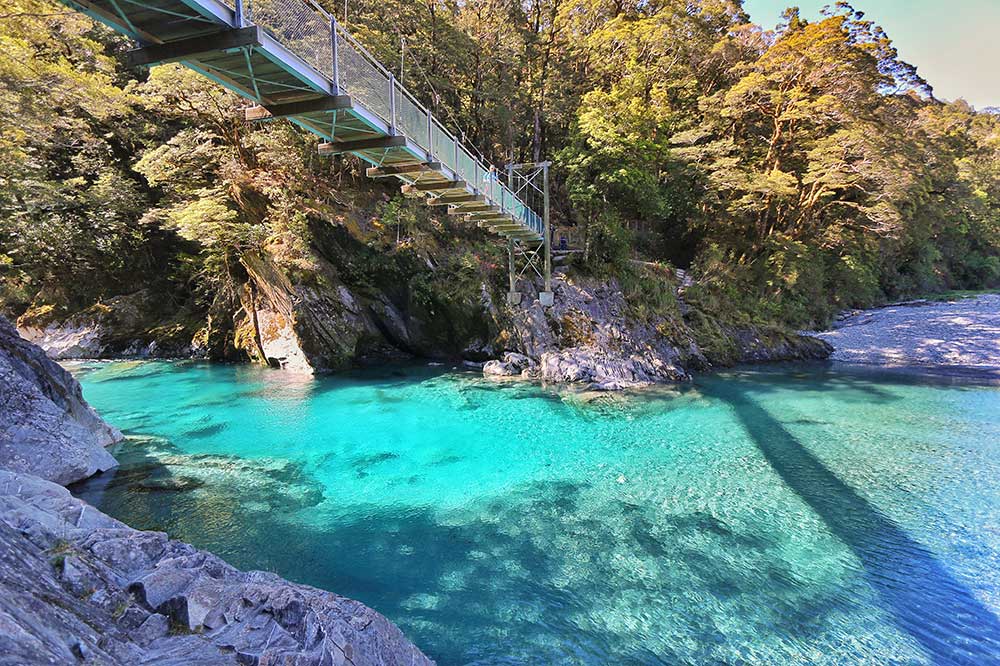
As you leave the pass another must do is the Blue Pools track – a five minute stroll to a series of icy, glacier fed springs with two swing bridges over the bluest water you’ve ever seen. From here it’s only an hour to Wanaka – you’re in my backyard now! You’ll pass through ‘the Neck’ a narrow spot where the edges of Lakes Hawea and Wanaka don’t quite meet, before arriving in my beautiful second home.
Wanaka is considered the quieter cousin of neighboring Queenstown, but that doesn’t mean it’s lacking in character. Obviously I’m a little biased, but seriously guys – Wanaka is epic. Home to a giant lake and picture-perfect mountains it’s a trans-seasonal town with countless things to do in both winter and summer. But first – coffee. Check out the cafe scene for a city-worthy breakfast and a shot of caffeine before exploring. A personal fave is Kai Whakapai on the lakefront or Double Black in Albert Town for a truly exceptional brew.
Wanaka has over 750 kilometers of trails to explore so come prepared to get your ‘walk’on! A great way to see the sights is to follow the millennium track – a gentle stroll round the edge of the lake. String out the hike by continuing on along to Waterfall Creek for sensational views of West Wanaka. If you’re up for something a little more strenuous, head up the famous Mt Roy track for some pretty special mountain vistas – but be warned – the hike is 3 hours of steady uphill climbing. Another great one to do is the Rob Roy Glacier. I’m talking pristine forest, rushing white water, and of course – an epic glacier. If you’re lucky, you might even see an avalanche – a common sight once the weather warms up!
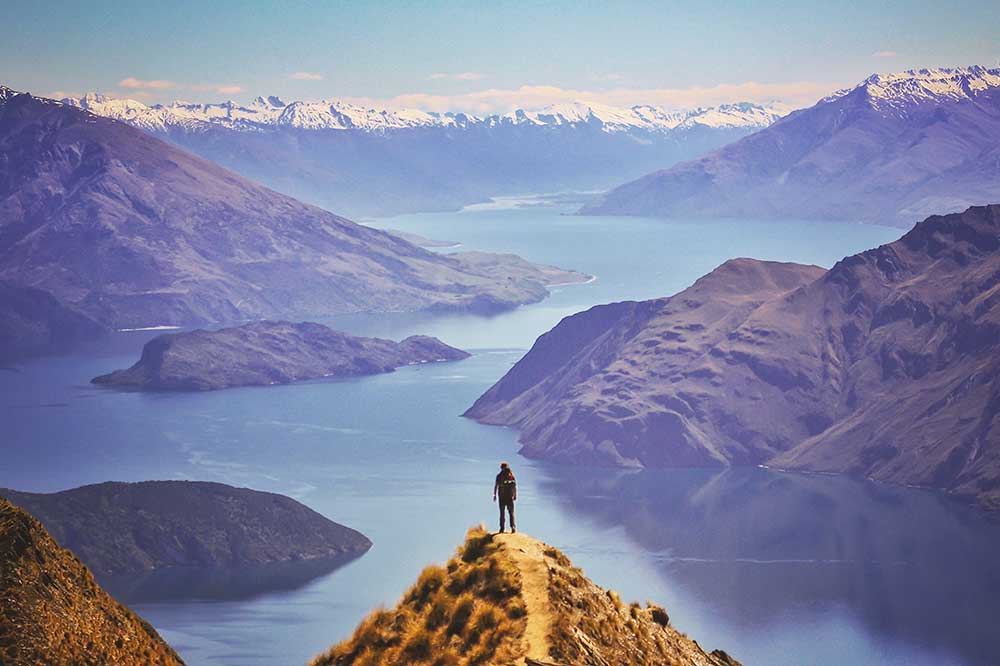
QueenstownCrossing the spectacular Crown Range
It’s only an hours drive from Wanaka to Queenstown over the Crown Range – and apretty spectacular one at that! You’ll travel through quintessential Central Otago countryside before climbing the tussock covered hills and descending to breathtaking views.
As the highest public access road in New Zealand, this trip will be a memorable one so keep a camera handy! Be sure to stop at the Cardrona Hotel and Pub, one of the oldest and (reportedly) one of the most photographed in the country – then park at the top for a seriously awesome selfie. Once you’re at the top of the Crown Range, if you’re game, leave the car behind and walk to the summit lookout for more massive mountain scenes. From here you’ll take a fairly hairy descent down a series of very tight switchbacks to arrive on the outskirts of Queenstown.
The ultimate adventure town, Queenstown is brimming with adrenaline inducing activities and is a popular tourist attraction year-round due to its charming alpine atmosphere. Also, the restaurant and bar scene is world-class. Like really good (If you’ve followed me for a while, you’ll know how I feel about food). Queenstown is definitely a party town.
Nestled on the shores of Lake Wakatipu, it’s surrounded by the Southern Alps and steeped in gold rush-era history meets the Lord of the Rings. My advice is to take a few days here to truly experience everything on offer. An early morning walk around the waterfront followed by brunch at Vudu or Halo is a fave, as is a stroll through the Botanical Gardens and some frisbee golf. If you’re up for something a little more strenuous, take the steep hour-long Tiki Trail track through beech and wilding pine forest and catch the gondola back down or for the truly committed continue on to the summit of Bob’s Peak. You can even paraglide off the top!
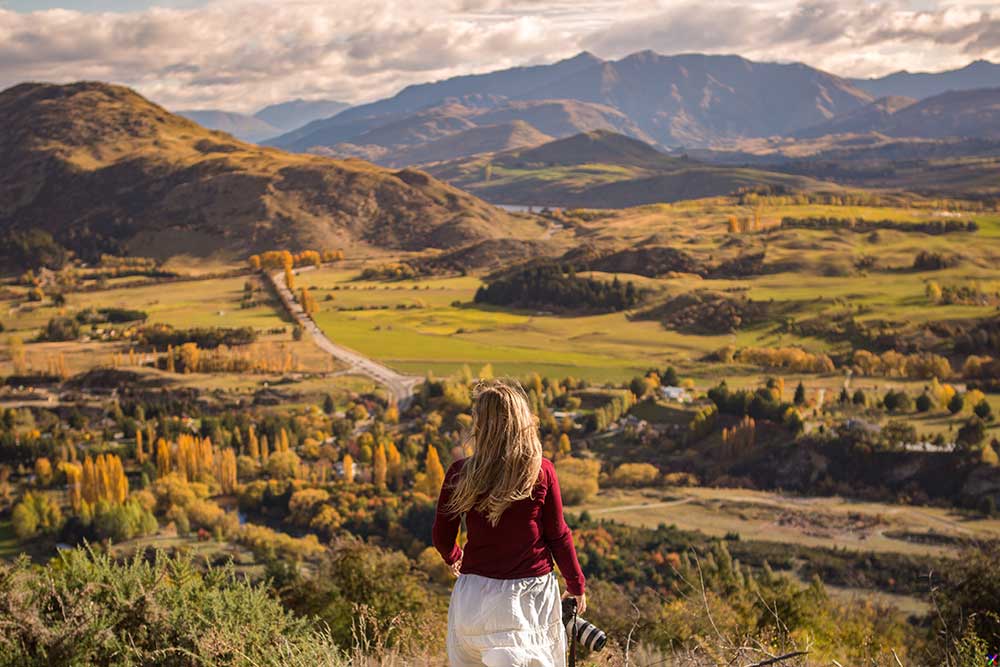
It’s only an hours drive from Wanaka to Queenstown over the Crown Range – and apretty spectacular one at that! You’ll travel through quintessential Central Otago countryside before climbing the tussock covered hills and descending to breathtaking views.
As the highest public access road in New Zealand, this trip will be a memorable one so keep a camera handy! Be sure to stop at the Cardrona Hotel and Pub, one of the oldest and (reportedly) one of the most photographed in the country – then park at the top for a seriously awesome selfie. Once you’re at the top of the Crown Range, if you’re game, leave the car behind and walk to the summit lookout for more massive mountain scenes. From here you’ll take a fairly hairy descent down a series of very tight switchbacks to arrive on the outskirts of Queenstown.
The ultimate adventure town, Queenstown is brimming with adrenaline inducing activities and is a popular tourist attraction year-round due to its charming alpine atmosphere. Also, the restaurant and bar scene is world-class. Like really good (If you’ve followed me for a while, you’ll know how I feel about food). Queenstown is definitely a party town.
Nestled on the shores of Lake Wakatipu, it’s surrounded by the Southern Alps and steeped in gold rush-era history meets the Lord of the Rings. My advice is to take a few days here to truly experience everything on offer. An early morning walk around the waterfront followed by brunch at Vudu or Halo is a fave, as is a stroll through the Botanical Gardens and some frisbee golf. If you’re up for something a little more strenuous, take the steep hour-long Tiki Trail track through beech and wilding pine forest and catch the gondola back down or for the truly committed continue on to the summit of Bob’s Peak. You can even paraglide off the top!
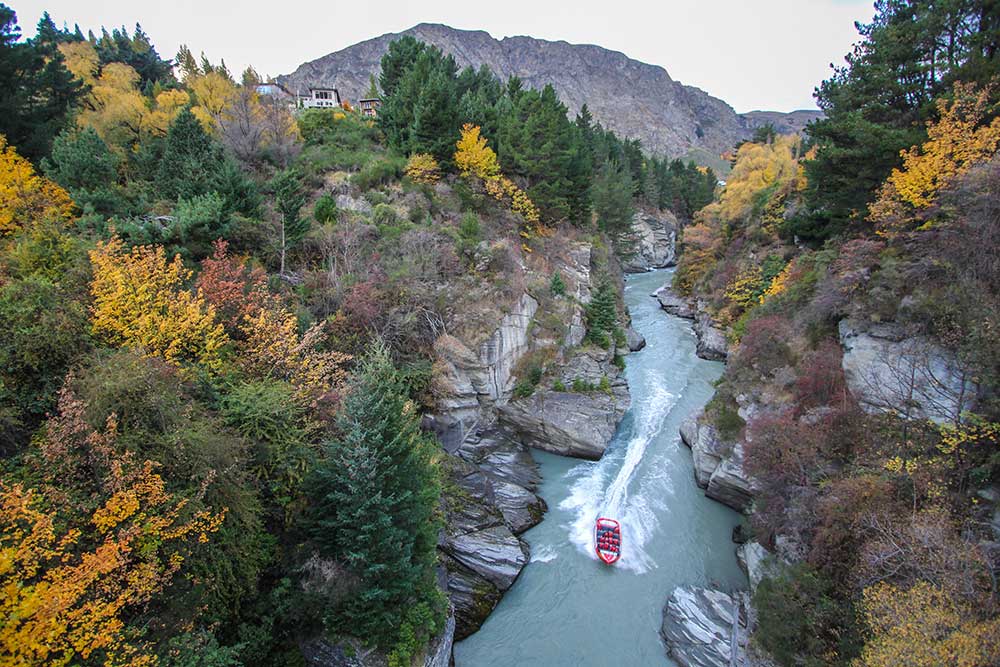
FiordlandNew Zealand’s crown jewels
The drive to Te Anau is roughly two hours and takes you from the Lakes District to the coastal Fiords. Skirting the shores of Lake Wakatipu you’ll follow the Remarkables mountain range to Kingston, home of the Kingston Flyer (a now defunct vintage steam train once used to carry passengers to the southern towns) to Fiordland, a playground for adventurers. Travel through Mossburn (randomly, the deer capital of New Zealand) before arriving in Te Anau, gateway to Fiordland National Park and Milford Sound.
Although Te Anau is considered a gateway town, It’s actually a pretty awesome destination on its own. Home to the largest lake in the South Island, it sprawls at the foot of the Southern Alps and in my opinion is some of the most pristine, untouched landscape in New Zealand. A mecca for hikers and mountaineers, two of New Zealand’s great walks (The Milford and Kepler tracks) begin here as well as several smaller day treks. If you have an obsession with birds like me, a must-do is a visit to the Wildlife Park – a ten minute stroll from the Department of Conservation Visitor Centre on the lakefront. You’ll get to see the re-discovered Takahe (errmagod guys!) and other NZ natives such as the Tui, Kaka, and Kea.
I definitely recommend visiting the Glow-worm caves for a chance to visit a 15,000 year old underground network still being carved out by the river. You’ll see ancient stalagmites and stalactites and get to experience these magical insects via underground boat ride. Both nerdy and romantic -it ticks all the boxes. Check out my guide for choosing between Milford Sound and Doubtful Sound.
From Te Anau it’s about an hour and a half into Milford Sound, but allow at least four hours to get there. Considered one of the most scenic drives in New Zealand, the road into Milford is actually insane. Home to beautiful and iconic landscapes, you’ll see lush glacier formed meadows, crystal clear mirror lakes, native beech forest and towering peaks. Did I mention the mirror lakes? And the towering peaks? In case you couldn’t tell, I love this place! I keep coming back again and again.
You’ll first follow the edge of Lake Te Anau through dense brush and rainforest. It rains so much here the centre line of the road is literally covered in green moss. Be sure to stop at said Mirror Lakes, and also take the time to do the Lake Gunn loop a little further ahead. Pass through the Homer Tunnel, a solid granite engineering marvel that took nearly 20 years to complete, and is pretty awesome to drive through. Before you begin the descent into Milford, stretch your legs on the 20 minute Chasm Walk – a gentle track leading to a spectacular waterfall where the Cleddau River spills out of solid rock.

Continuing on, as you arrive into Milford you’ll see Mitre Peak on full display. This iconic sight is the hallmark of Milford Sound and you’ll recognise it from advertising brochures round the world. Sheer cliffs cloaked in vegetation give way moody skies and tumbling falls. Yes, I know I’m gushing again, but seriously! You’ll get it when you arrive.
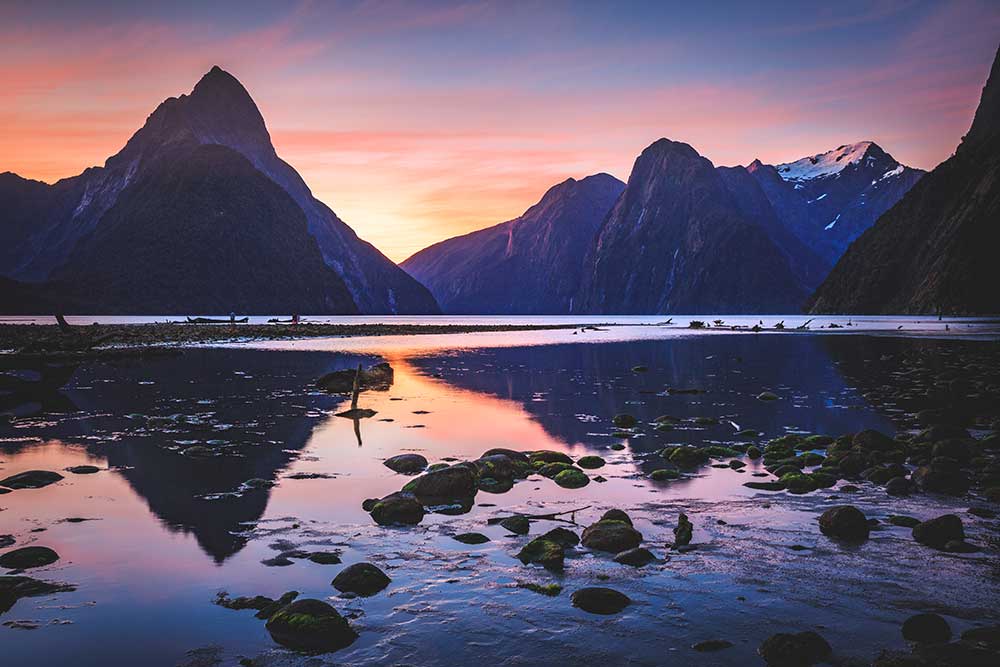
As the most accessible Fiord in the National Park, Milford is 16 kilometres long and best explored by boat. Book a cruise before you go and if you’ve got the time – splurge on an overnight trip – it’s well worth it!

Milford on a clear day is spectacular, but Milford in the rain is truly something else – when its hundreds of waterfalls triple in volume. With an average annual rainfall of 6,813mm it’s known as the wettest place in New Zealand. Marine mammals such as dolphins and seals are frequent visitors, as is the rare fiordland crested penguin. A visit to the underwater observatory is a must, and a guided kayaking tour through its many secluded bays will round off your visit nicely.
